
 8 min read
8 min readDiscover Niche Keywords in 2 Simple Steps
The Emergence of Niche Keywords and Their SEO Impact
To do well in SEO, it's important to use keywords smartly to show up on search engines. Focusing on niche keywords is a good strategy because they are about specific topics that interest a particular group of people. Using these keywords can bring more targeted visitors to your website and help you avoid competing with too many other sites.
Understanding the origins and impacts of niche keywords could very well be the competitive edge needed to ascend in search rankings. When a main product or service blossoms in popularity, it naturally births an array of related, specific topics—these burgeoning topics are the cradle of niche keywords. Frequently overlooked by websites that focus on the primary topic, these niche areas are ripe with opportunity, offering a growing number of searches and minimal competition.
Using niche keywords is like finding hidden gold. They are a growing SEO resource ready for smart people to use. Their value comes from aiming at specific parts of the market, cutting down competition, and increasing the chances of making sales.
But a word of caution—navigating the intricate world of niche keywords is not a venture to be taken lightly. This requires a shrewd overhaul of your current SEO blueprint, abiding by the shifts in the marketplace. As new niches surface, the savvy business aligns its keyword strategies accordingly, ensuring each chosen term complements the business and propels it forward. Join us as we unravel the intricacy of niche keywords and their ever-growing SEO impact.
Discover Niche Keywords in 2 Simple Steps with Seodity
SEO is like exploring a huge sea, with niche keywords being your guides to untapped areas full of opportunities. We'll show you how to find these keywords in two simple steps using Seodity. Seodity makes it easy to find specific keywords, turning a difficult task into something you can do. It's perfect for SEO experts or business owners wanting to improve online. We'll give tips for finding valuable, uncompetitive keywords for your specific market. Let's start this journey and use niche keywords to boost your SEO.
Step 1: Start with Broad Keywords
Finding general keywords related to your business or topic. These broad keywords help direct your search to areas with opportunities. From there, you'll identify more specific keywords that target a smaller, more specific audience.
Start by creating a short list of general keywords related to your business. Think of words that cover a broad range but are still relevant to your industry, like "bakery," "fitness," or "tech gadgets." These keywords give a broad overview and should represent your area's wide range of topics.
Identify your main keywords. They will guide you to more detailed keywords related to your specific topic. By focusing on these main terms, you can find the exact phrases that will attract the right visitors to your website. Doing this step prepares you for a successful keyword strategy that ideally fits your SEO needs.
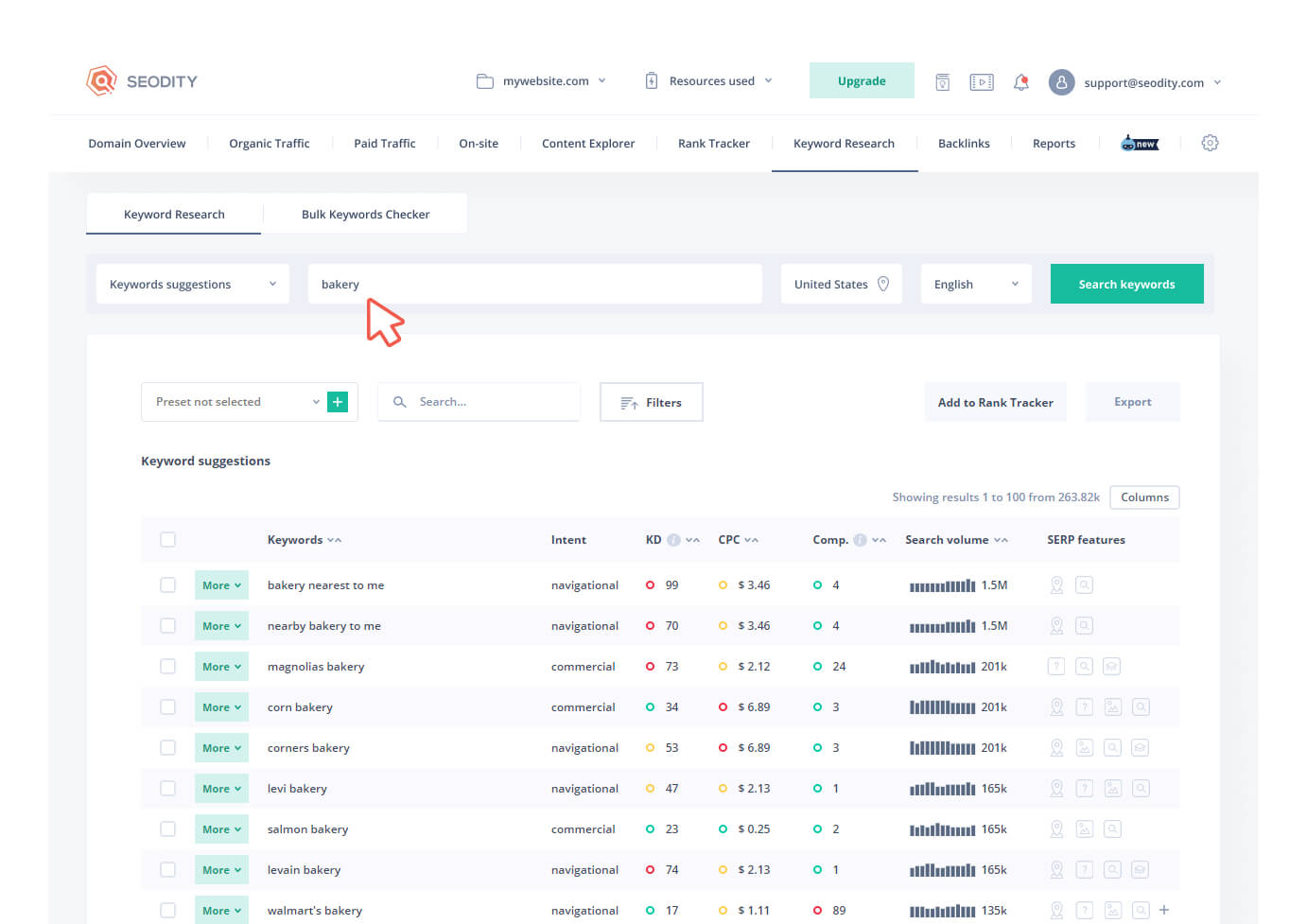
Step 2: Utilize Keyword Difficulty and Relevance
Now that you have your basic keywords, focus on the next step: finding your specific niche keywords by looking at how hard they are to rank for and how relevant they are. The hardness to rank, shown as a number, tells you how competitive a keyword is. Usually, it's best to go after less competitive keywords, especially if your website is new or if you want to get noticed online quickly. Tools like Seodity make it easier by giving you scores to help you find keywords you can realistically aim to rank for.
Choosing keywords isn't just about finding easy ones; they also need to match what you offer and interest your audience. They should connect your business's strengths with what your customers want and need.
Seodity helps you find easy-to-rank keywords related to your business, which can attract and convert customers. Using this method, you can build a solid base for improving your online presence and connecting with your audience.
In Seodity, we have a preset for finding niches. To use it, click "Presets" and select "Niche Finder".
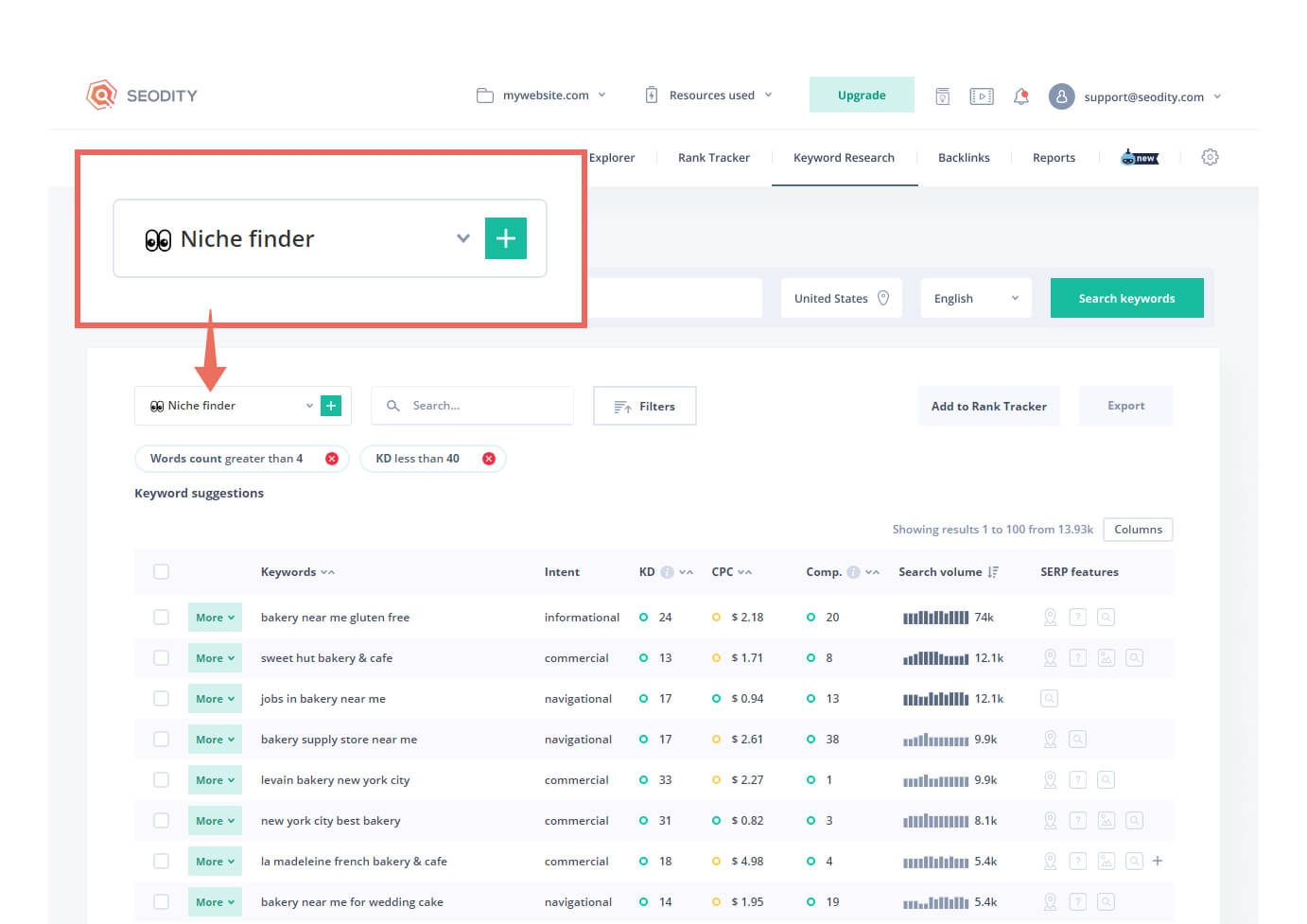
Create a list of keywords for the identified niche. You can achieve this by selecting them and exporting them.
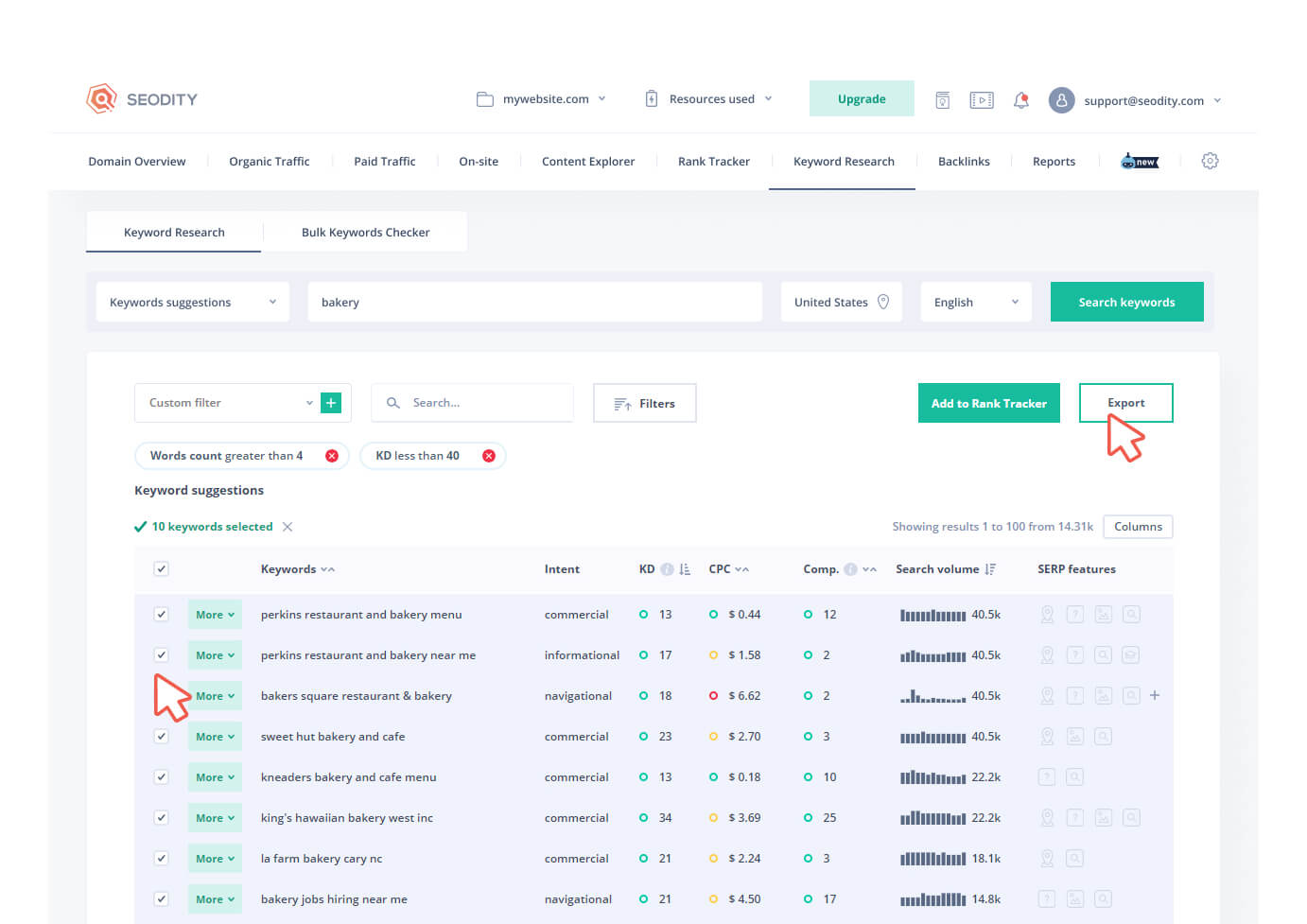
Identifying Profitable Niche Keywords
Target profitable niche keywords like searching for gems in the sand — it needs smart tactics and a good instinct. Go for keywords a lot of people search for, ones that show they want to buy or do something, like "buy," "download," or "order."
To unearth these profitable niche keywords, examine the broad keywords that align closely with your offerings. Using Seodity, you can further refine your search by utilizing the "filters" option. Focus on those keywords that reflect a high search volume, indicating their popularity among users, while monitoring the competition level and intent alignment using Seodity's specialized niche finder preset.
As a case in point, if your business specializes in health-conscious baked goods, a keyword like "gluten-free bakery" may have a lower difficulty score and high search volume, signifying its lucrative nature for your SEO campaign.
Employ Seodity's niche finder feature to parse through the data and pinpoint those niche keywords that have a tangible search presence and a propensity to lead to conversions, increasing the likelihood of transforming searchers into customers. In doing so, your business can position itself to capture the attention of a dedicated and conversion-ready audience, marking a significant step in the continuous evolution of your SEO strategy.
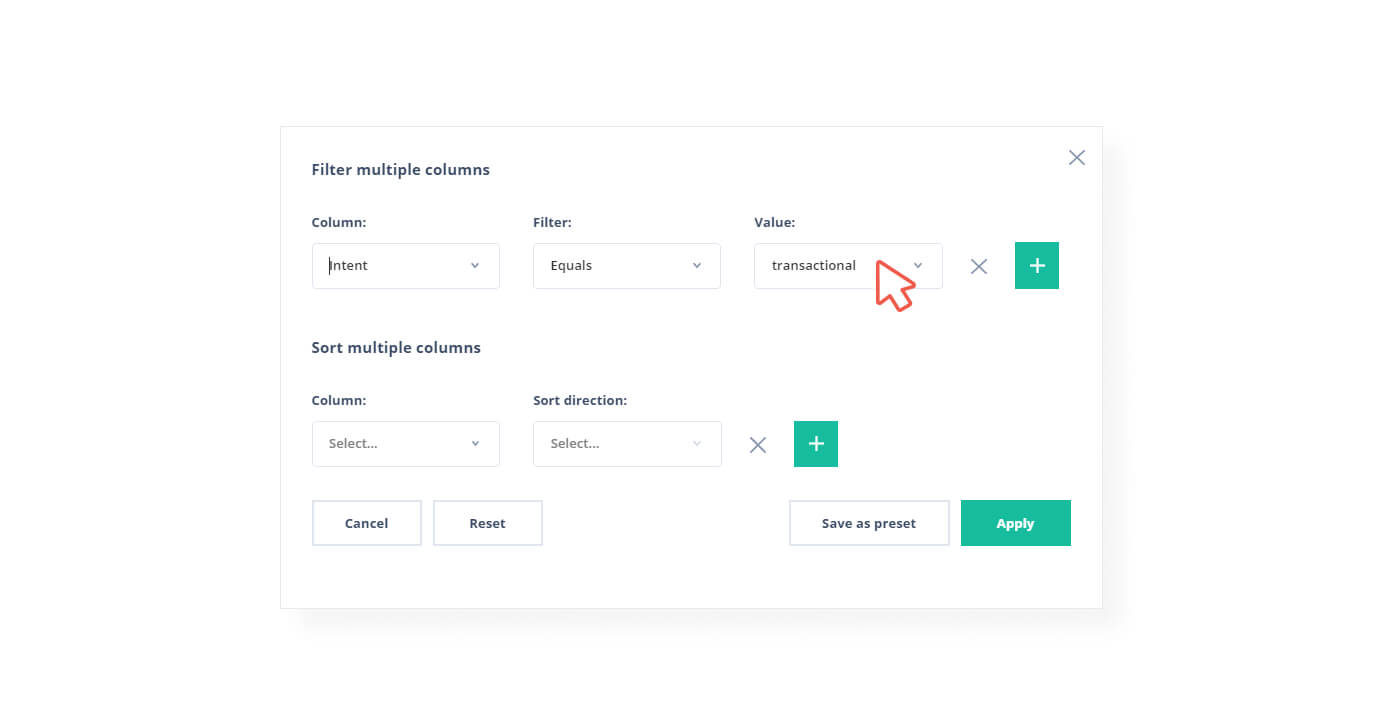
As you can see, some keywords have relatively low keyword difficulty but a high competition level. What does this represent?
The Google Ads parameter determines the competition level. High competition signifies that there are numerous paid ads associated with those keywords. This factor can also indicate that these specific keywords are profitable.
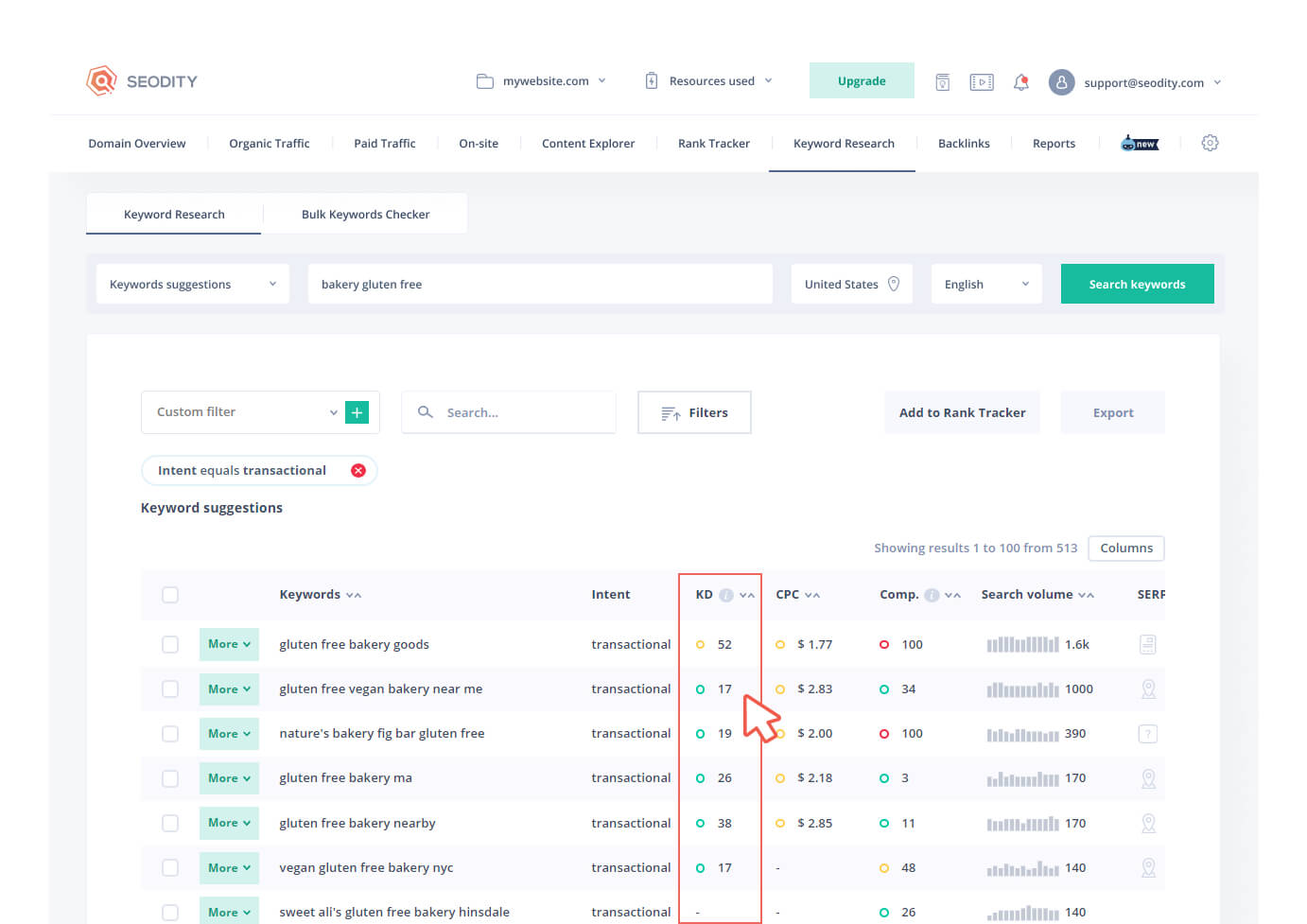
What is the best niche item to sell on Amazon or any other marketplace?
You can check such niche by adding to the broadkeyword name of the marketplace, e.g. "lego amazon".
And set the "niche finder" filter.
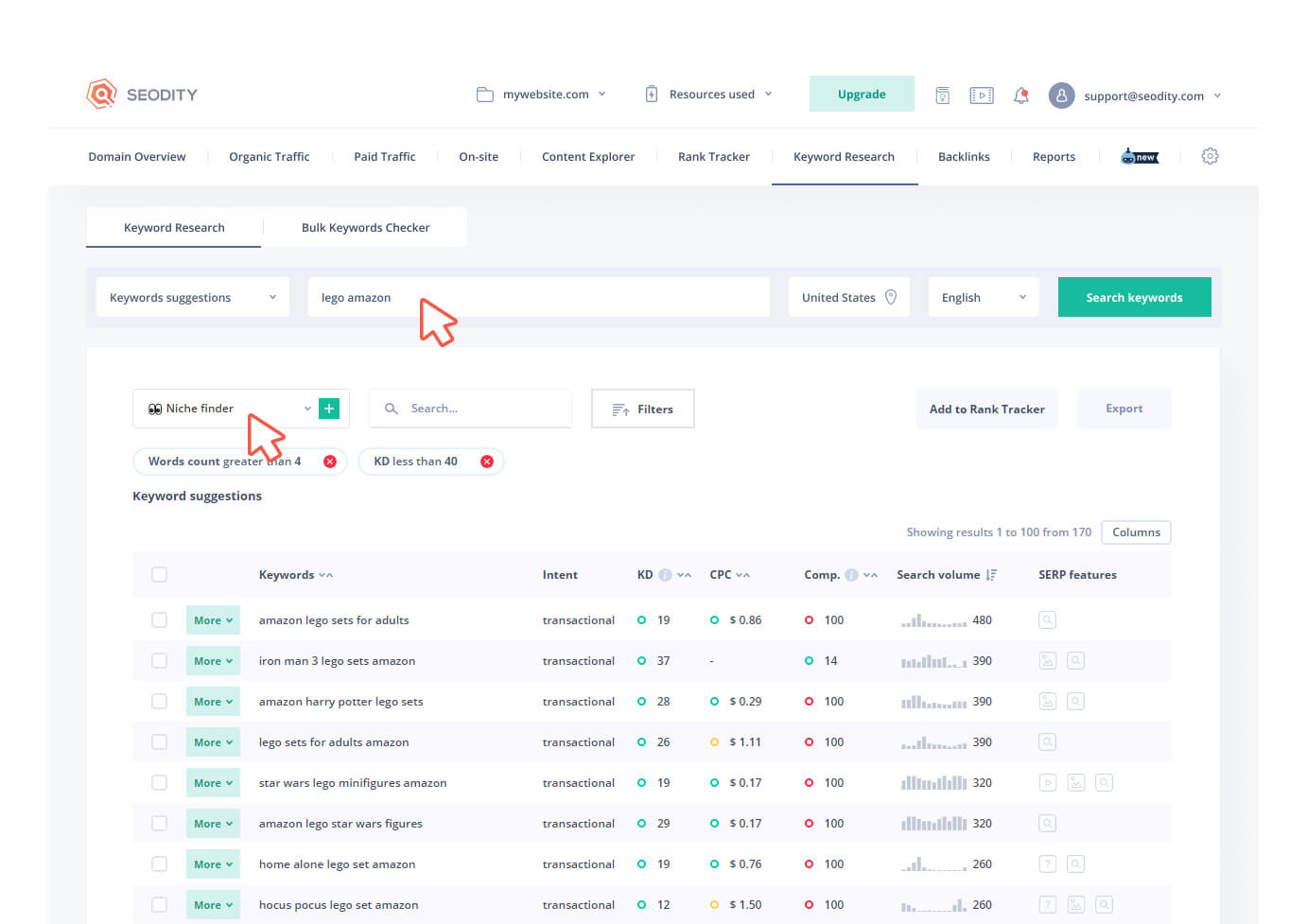
Filtering Keywords by Intent for Maximum Conversion
After mastering the identification of long-tail, niche keywords with low difficulty scores, a crucial next step is to filter them by their searcher's intent. This advanced tactic refines your keyword strategy to attract visitors and drive actions that align with your business objectives. Intent categorization separates the tire-kickers from potential buyers, allowing you to tailor your content to the audience's position in the buyer's journey.
Within Seodity, this process is streamlined by using the intent filter feature, a powerful facet of the tool that classifies search terms into informational, navigational, and transactional categories. By focusing on transactional keywords, which indicate a user's readiness to make a purchase or engage in a business transaction, you can hone in on a segment of searchers closer to the bottom of the sales funnel.
A practical approach is to use the 'filters' function in Seodity to segregate keywords by their intent. After deploying relevant broad keywords, apply the intent filter to surface terms with a 'transactional' classification. These keywords signify a higher likelihood of conversion, as they are used by individuals in search of specific products or services to meet an immediate need.
Selecting keywords based on intent maximizes your content's efficacy, ensuring that your site's visitors are not just passing through, but are there with a purpose — to take action. By aligning your content to match these transaction-driven searches, you optimize your web pages not just for traffic, but for conversion — the true endgame of any successful SEO strategy.
How do I find a good niche?
For any business, niche relates deeply to the product or service you intend to market. Having in-depth knowledge about your offerings sets the stage for your success. With modern tools like Seodity, you can analyze broad keywords, find your niche, and optimize your SEO strategy.
However, niche identification is no menial task — it demands comprehensive understanding, constant research, and regular monitoring of your business sector. By using credible sources, staying up-to-date, and presenting your information in layman's terms, you can craft a compelling story that resonates with your audience, thus maximizing your digital reach while honing your unique position in the marketplace.
Using Modern SEO Tools for Niche Identification
The tools at the disposal of today's SEO professionals are not only sophisticated but also quintessential for identifying and capitalizing on niche keywords. These modern marvels of technology provide an arsenal of features designed to fine-tune your SEO strategy to near perfection. The role they play in uncovering niche keywords—a process once considered profoundly challenging—is nothing short of revolutionary. Among these tools, Seodity emerges as a significant ally, with its tailored capabilities to uncover niche keywords that could transform the SEO campaign of any business.
Seodity, for instance, simplifies the arduous task of keyword identification by organizing vast amounts of data into actionable insights. Its niche finder preset—a tool specifically designed for niche keyword discovery—is a testament to its utility. By enabling SEO professionals to identify areas of low competition and high relevance to their content strategy, Seodity ensures a targeted approach to market penetration. What sets it apart is the accuracy with which it can find and categorize the potential of each keyword, making it an indispensable tool in the SEO practitioner's toolkit.
The use of such tools is not just a matter of ease; it's a strategic imperative. As the digital marketplace becomes increasingly saturated, the ability to quickly and effectively identify untapped niche markets is essential. With Seodity and similar platforms, you can scan the horizon of your industry's keyword landscape, uncovering opportunities that others may have missed. By incorporating these tools into your regular SEO workflow, you ensure that your SEO strategy is as dynamic and adaptive as the digital market itself, allowing you to stay one step ahead in the race for online dominance.
Most SEO tools feature keyword research, which you can use:
Seodity - This tool is best for SMBs and SEO freelancers. It offers predefined filters for niche research.
You can also use a Free niche finder powered by Seodity.
Ahrefs - This all-in-one SEO tool is great for agencies, particularly for technical SEO.
Semrush - An excellent option for enterprises, it serves as an all-in-one marketing tool.

Marcin is co-founder of Seodity
.svg)
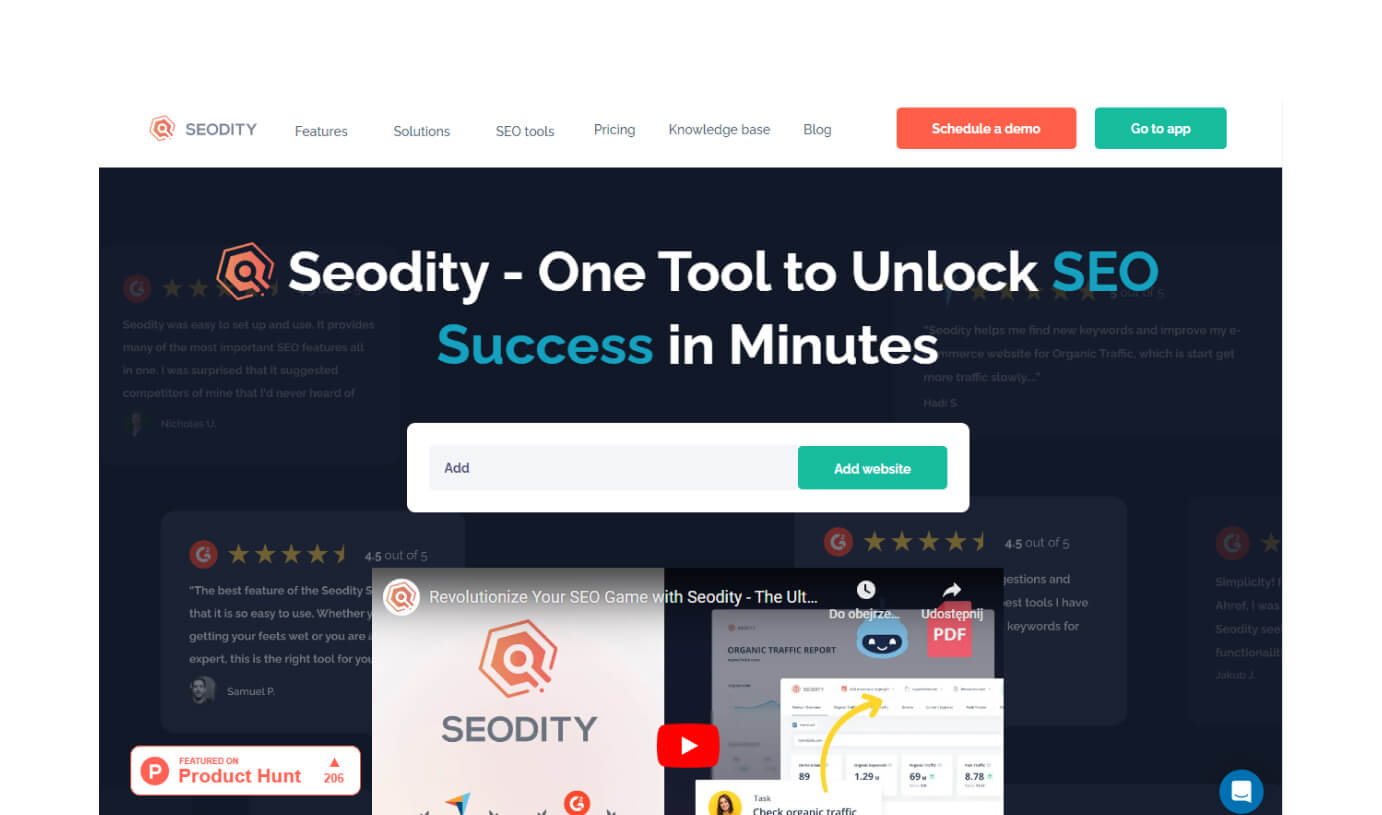
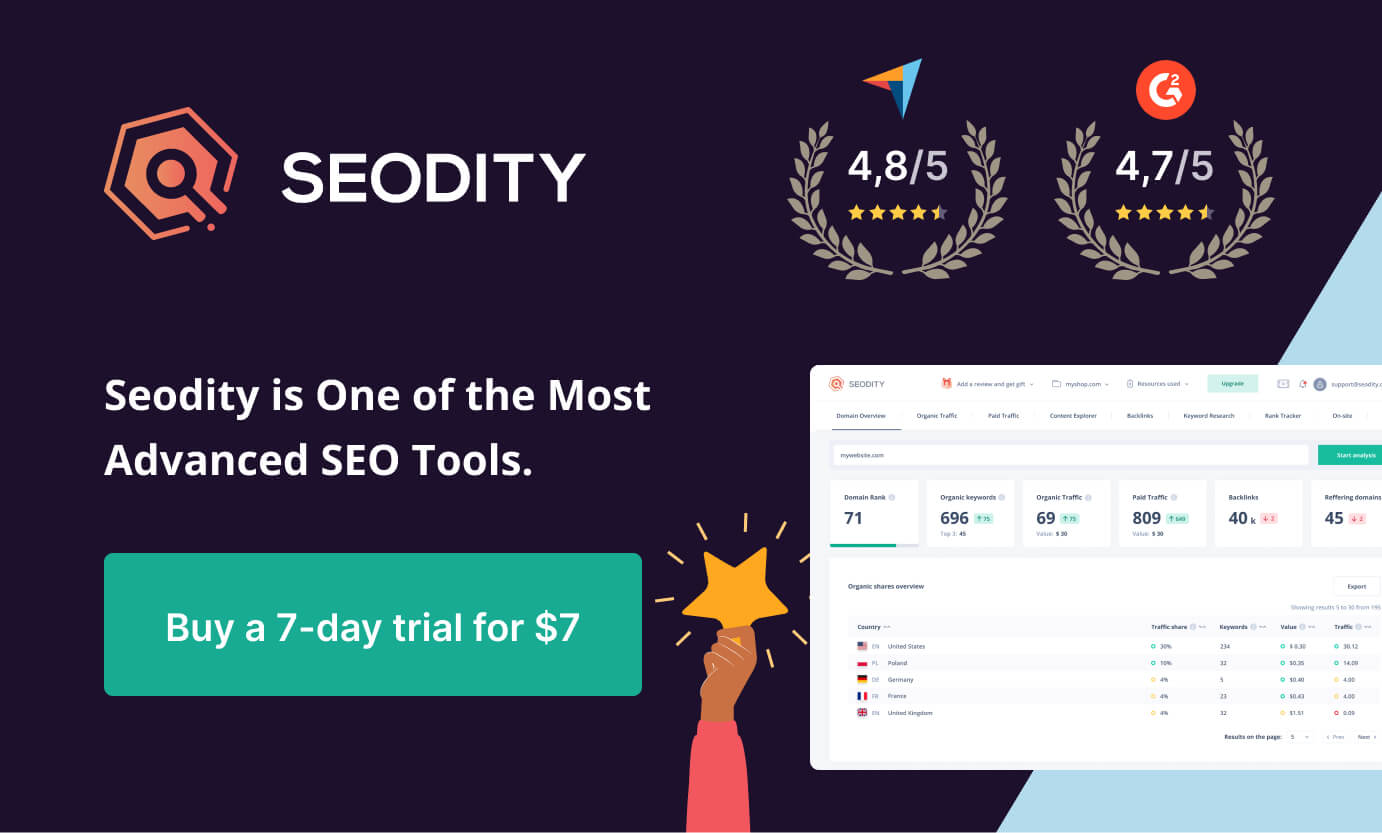


![How to Do Keyword Research for SEO [5 Easy Steps]](https://storage.googleapis.com/seodity/public/blog/images/5af87a0781ed4987974302038eb0451d.jpg)
![8 Best Keyword Research Tools in 2021 [Free Apps Included]](https://storage.googleapis.com/seodity/public/blog/images/3121df48fd0b4dad8284e21e9a297b38.jpg)

